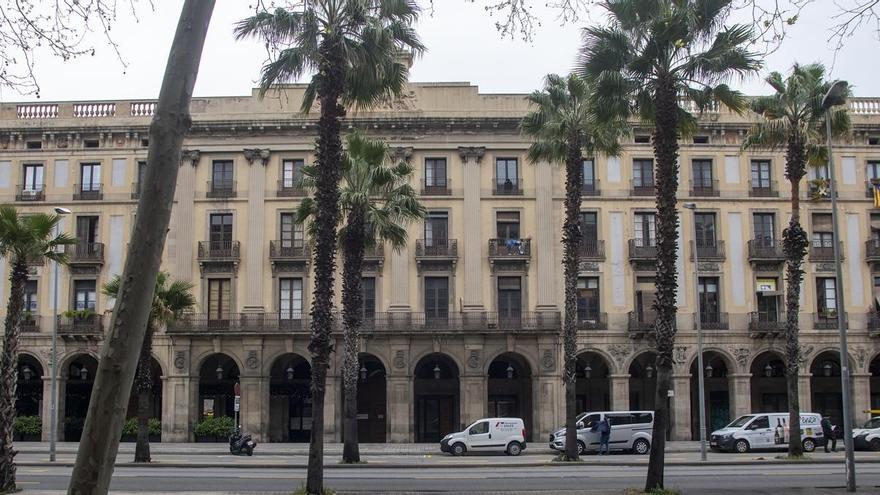Is there an equation that relates the slave-owning roots of some of the great Catalan fortunes of the 19th century with the incorrigible zipizape of the price of rental housing in Barcelona? In physics this is called, with a broad brush, the theory of everything, that is, a single law that brings together all known phenomena. Dozens of great physicists have tried, for example, to marry the behavior of gravitational and electromagnetic forces into a single law, and, for now, there is no way. Consider that something has to do with the endemic real estate anomaly in Barcelona, which, as it will be seen after 100 years ago, was not very different from today, with the way in which the construction of Barcelona was financed after the fall of the walls, that is, With the benefits of employing slave labor in the colonies, it is perhaps more feasible. Or not. Let’s see.
This attempt to formulate a theory of the whole ‘negreroinmobiliaria’ was born from the reflection that a reader put on the table when on January 31st a review was published in this newspaper on the most exhaustive biography published to date on Antonio López, Marqués de Comillas, the slave merchant always cited in Barcelona’s chronicles on this matter, often at the cost of not talking about others. Montse Faus, the reader, explained that even before the pandemic, before the profession of tourist guide was liberalized to ‘Glovolian’ levels, she had precisely a route through the slave-owning Barcelona. He offered to dust it off, as a complement to the portrait on López or for those who still want to go deeper. This is how the challenge arose.
The appointment with Faus It was in front of the Cathedral, because right there, in front of the doors of the temple, the slave market was set up in the Middle Ages. Although it is on the run before going to the 19th century and entering the theory of everything, it is worth reviewing some of the previous episodes that the route includes.
Roger de Flor, a mercenary with a street in Barcelona, made a bonus with slaves. They were different times. Trading with humans was so common during the Middle Ages that, by the 15th century, of the 30,000 inhabitants that Barcelona had, between 3,000 and 5,000 were slaves.
The ruinous business of the Generalitat of the 15th century
Sometimes an attempt is made to sweeten that stage by mentioning cases such as that of Lluc Borrassà Y George of GodBoth great artists. The first was a Tatar slave who Lluís Borrassà He bought from a Mallorcan carpenter on December 19, 1392. In the Diocesan Museum of Barcelona there is a panel of Saint Stephen, coming out of his remarkable gifts as a painter. The second was captured in the 14th century by a Catalan privateer and was such a good sculptor that he worked on the royal tombs of the Poblet Monastery. This trade did not make him forget, however, that he was only a slave. He fled several times and was captured several times, which invites, he explains Faus, to remember one of the most ruinous companies promoted by the Generalitat in its many centuries of history, to scale (excuse the comparison, but feel like it) of the L-9 subway line.
It happened at the beginning of the 15th century, under the ‘presidency’ (if that can be said so) of Joan Desgarrigues. The idea seemed like a money-making machine. Slave owners were obliged to take out insurance against the risk of flight. If they were slaves, the insurance was voluntary, because women were supposed to flee in fewer numbers. Therefore, the Guarda d’Esclaus was founded, a civil servant body that, in case of escape, had two months to locate the slave and return it to its owner. In case of failure, the Generalitat compensated the master for the declared value of the slave. Due to the lack of skill of the officials or due to the large volume of leaks, the Guarda d’Esclaus was declared bankrupt in 1431.
All this, however, are only anecdotal preliminaries before reaching the 19th century, that century in which hundreds or perhaps thousands of Catalans left to make the Americas and many of them, with more or less fortune, entered the path of the ethical destitution that went through Antonio Lopez. To some of them, that has not even taken its toll on posterity, as to Miquel Biada, great promoter of the railroad in Spain and at the same time defender of slavery. In Mataró they thank him so much for the first and they apologize so much for the second that not only does he have a statue in the town, but even a secondary school bears his name.
The Catalan presence in Cuba, for example in 1840, was so remarkable that there is evidence that only 170 merchants from Sitges were on the island, not all, of course, slave traders, but the figure sets the debate.
The question is how those fortunes that were amassed to the west of the Atlantic later affected Barcelona if their owners, already immensely wealthy, settled in the city. Josep Xifré, a slave trader among many other things within his business network, left the city as an inheritance the Porxos d’en Xifré, a monumental estate on the Paseo de Isabel II, of which the restaurant 7 stands out since 1837. Portes, when the most curious thing is that this building is the main and only protagonist of the first photograph taken in Spain.
Next to it stands another farm financed by slave labor, the Porxos de Vidal-Quadras. But from the point of view of the story that it is intended to support here, the theory of the whole black real estate, the cornerstone is Thomas Ribalta, son of Barceloneta, Indian of great fortune, and, who on his return to his hometown bought the Palau Marc, at number 8 of the Rambla, today the headquarters of the Department of Culture of the Generalitat, with a thick block of bills, a farm in which he spared no expense. Ribalta is an interesting character because with his fortune he did not create a new job or invested in the then emerging industries, such as Biada with the railroad, but opted for the very Barcelona and comfortable solution of investing in the purchase of buildings and living on rental income.
The rent bubble of 1917
Vertical ownership is a very characteristic of Barcelona. When the urban leasing law put an end to old rents in 2014, the closure of emblematic stores affected Barcelona more than Madrid because in the capital the business owner is more often the owner of the premises. In Barcelona, dozens of iconic stores have died for not being able to assume the increase in rent. The owners have almost always been insensitive to the loss of the city’s commercial pedigree. The farms are not now of the descendants of ancient Indians. Sure. Many have sold. Investment funds have taken over. But the evil that afflicts the city is the same. Perennial. In 1917 a motion was debated in the plenary session of the Barcelona City Council with which it was intended to require the central government to regulate the price of rents. Specifically, it was claimed that they should fall at least to the levels of August 1914, because it was then that the First World War broke out, which in Barcelona caused a speculative bubble of aúpa. One of the councilors who defended such a measure (said only as the icing on the cake of such a story) was Lluís Companys, then councilor of the opposition. After 100 years, the debate is still stalled at the same point as then.
It may interest you
That pulse, which at this point does not surprise anyone, was won by the Biada of the time, many of them simple rentiers, a ‘trade’ that the French economist Pierre-Yves Gómez He defined bloodily when he said that it consists of benefiting from the wealth created without feeling obliged to participate in the productive effort. More or less, it seems like a theory of everything. Or not?
A place for Clotilde Cerdà
In ‘Antonio López, not only a slave’, that is, the article that has given rise to this second installment, it was emphasized that although the Marquis of Comillas no longer has a statue in Barcelona, the square where his figure was erected still retains its Name. He is waiting for a new baptism, for which there is a proposal from the municipal government team. He pretends that his name is Idrissa Diallo, in memory of a Guinean who died in 2012 in controversial circumstances at the Center for the Internment of Foreigners (CIE) in Barcelona. Raising him to the altar of the Barcelona gazetteer is a noble purpose, although Montse Faus, our guide to the slave route, argues that an equally or more interesting proposal would have been for the square to be named after Clotilde Cerdà, daughter of Ildefons Cerdà, a woman to the one that the city has dedicated an interior of a block next to the street of Marina but that would deserve much more. A feminist and activist against the death penalty, she also fought on the front lines for the abolition of slavery. It is not that the current Antonio López square is a postcard, but if it is dedicated to Clotilde Cerdà at least it would already be more dignified than the one that Barcelona reserved for her father, right on the border of the municipality.
–
– .


